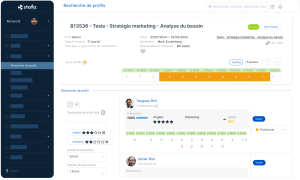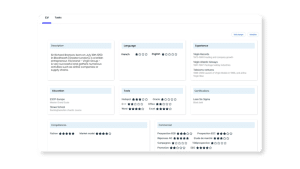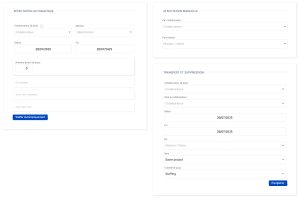Comment mettre en place une allocation des ressources optimale ?

Souvent perçu comme une contrainte, l’allocation des ressources s’avère en réalité un véritable levier de performance en gestion de projet. Temps, compétences, collaborateurs, budget ou encore matériel, les ressources et leur planification minutieuse sont indispensables pour atteindre les objectifs stratégiques de l’entreprise.
Toutefois, mettre en place une allocation efficace des ressources n’est pas toujours une démarche simple ! C’est pourquoi nous vous proposons un guide complet pour non seulement vous aider à comprendre les enjeux d’une allocation des ressources optimale, mais également pour vous aider à l’implémenter dans votre structure grâce à des outils adaptés.
Qu’est-ce que l’allocation des ressources en gestion de projet ?
Allocation des ressources : définition
L’allocation des ressources, parfois appelée affectation des ressources, consiste à déterminer la manière dont les ressources sont distribuées au sein d’un projet.
On définit par ressource aussi bien ce qui est tangible, comme le matériel ou le budget, que ce qui est intangible, comme les compétences ou le temps disponible.
Cette étape cruciale, effectuée lors de la planification de projet, implique de lister les différentes ressources et de les répartir pour maximiser la productivité. Elle est considérée comme stratégique : il serait difficile pour l’entreprise d’atteindre ses objectifs sans une allocation des ressources optimale et réfléchie.
Différences entre allocation, lissage et nivellement des ressources
L’allocation des ressources peut facilement être confondue avec le lissage ou le nivellement des ressources. Voici un récapitulatif pour vous aider à clarifier chaque concept.
- L’allocation des ressources planifie qui fait quoi, quand, et comment ; elle attribue les ressources à chaque tâche spécifique.
- Le lissage des ressources (Resource Smoothing) répartit de manière homogène les ressources afin de respecter le calendrier. Il évite les surcharges ponctuelles, en maintenant la durée du projet.
- Le nivellement des ressources (Resource Leveling) tolère un ajustement du calendrier. Cette technique évite également la surcharge des ressources, mais permet un décalage de la date butoire. Cela peut s’avérer pertinent lorsque les ressources sont limitées ou partagées entre plusieurs projets.
Pourquoi optimiser l’allocation des ressources ?
Un levier stratégique à plusieurs niveaux
L’allocation des ressources s’avère stratégique sur de nombreux aspects, que nous allons passer en revue. Ses enjeux diffèrent d’une structure à l’autre car ils dépendent des objectifs de l’entreprise, de son secteur, de sa culture ou encore des contraintes humaines et financières.
Performance et croissance
Une allocation optimale des ressources accompagne la croissance de l’entreprise en boostant sa performance. Cela passe par deux aspects :
- L’optimisation du taux de charge, qui permet d’éviter la sur ou sous sollicitation des ressources.
- La maximisation du taux d’occupation, qui aide à répartir les différents talents sur des missions à forte valeur ajoutée.
Gestion des compétences
Plus la mission nécessite des ressources non interchangeables (expertises spécifiques par exemple), plus l’allocation des ressources doit permettre de sélectionner le bon profil. Cela est rendu possible grâce à un audit des compétences disponibles ou à l’anticipation des besoins en formation ou recrutement.
Optimisation financière
Une allocation des ressources optimisée permet d’améliorer la rentabilité des projets.
En procédant à une affectation stratégique des différents profils sur les projets, à des timings adaptés, il est possible de maximiser les marges et donc les revenus.
Profils et niveaux d’expérience
L’allocation des ressources permet également de réfléchir à la séniorité des profils lors des affectations. Ainsi, les niveaux d’expérience doivent être pris en compte : en ESN ou agence, les profils sénior doivent être moins sollicités sur de l’opérationnel pur, au contraire des profils plus juniors. En effet, les séniors consacrent une partie de leur temps aux activités internes telles que le mentoring, la formation ou encore la stratégie.
Engagement des équipes et marque employeur
La répartition des ressources a un fort impact sur l’engagement des collaborateurs et peut d’ailleurs être utilisée comme levier afin d’améliorer la qualité de vie au travail. En effet, elle contribue à :
- éviter les surcharges, limitant burnout et turnover,
- optimiser la charge de travail de manière équilibrée,
- considérer les appétences, renforçant ainsi la motivation et l’engagement des collaborateurs.
Gestion RH
La planification des ressources est également essentielle au recrutement car elle met en lumière les compétences manquantes. Ainsi, elle oriente les recherches et permet de proposer des plans de formation adaptés aux missions.
Enjeux opérationnels de l’allocation des ressources
Efficacité et performance
L’allocation des ressources doit être réalisée de manière à aligner les équipes, le calendrier, et les budgets sur les objectifs de l’entreprise. Disponibles au bon moment, les ressources contribuent à un gain de temps en étant disponibles en temps voulu, maximisant ainsi le potentiel commercial.
Visibilité
En permettant une vision claire sur les disponibilités, les compétences et les affectations, l’allocation des ressources limite les frustrations causées par une distribution de la charge inadaptée.
Rentabilité
Lorsqu’elle est optimisée, l’allocation des ressources améliore la rentabilité car elle permet de minimiser les coûts. Cela passe par la limite des retards, des temps d’inactivité, ou encore le placement stratégique des profils les plus rentables.
Réactivité et flexibilité
L’affectation des ressources doit être flexible : elle doit permettre d’adapter les ressources en cas d’imprévus. Complémentaire à la gestion des risques, l’allocation des ressources doit être revue en cas de changement de périmètre ou de facteurs externes (économiques, environnementaux, politiques…).
Outils
L’utilisation d’un logiciel de staffing facilite l’allocation des ressources. Celui-ci permet généralement de gérer dynamiquement les ressources pour coordonner l’ensemble des projets au sein du portefeuille.
Ménager les équipes
Une allocation optimale des ressources permet de maintenir l’équilibre de la charge de travail. Ni sur-utilisée, ni sous-utilisée, les équipes restent motivées et engagées.
Cela contribue à accroître la satisfaction des collaborateurs.
Des enjeux différents en fonction des profils
L’allocation des ressources a un impact différent en fonction des profils de l’entreprise.
- Pour le chef de projet, elle permet de disposer de la ressource adéquate, au bon moment.
- Pour le CEO et le COO, elle contribue à optimiser l’utilisation des ressources en maximisant la performance des équipes.
- Pour les ressources humaines, elle aide à planifier les besoins en staffing et à gérer le développement des compétences.
- Pour le DAF et le CFO, elle aide à la rentabilité des projets.
- Pour les consultants, elle permet de proposer des missions adaptées à leur profil et à leur carrière.
- Pour le PMO et le responsable staffing, l’allocation des ressources permet d’arbitrer objectivement ses choix, basés sur des données fiables.
Comment mettre en place une allocation des ressources projet optimale ?
Planifier la gestion de la capacité
La gestion de la capacité (ou capacity planning) dans le cadre de l’allocation des ressources implique quatre étapes.
- Faire l’inventaire des ressources disponibles
Cela nécessite de lister les ressources disponibles : compétences, collaborateurs, temps, outils, budget ou encore matériel.
- Identifier les besoins en ressources
Il s’agit de cartographier les besoins afin d’organiser les ressources. In fine, l’allocation des ressources doit permettre de répondre aux objectifs stratégiques de l’entreprise. En effet, la prévision des ressources projet aide à déterminer si les compétences nécessaires sont disponibles en interne ou s’il est nécessaire d’externaliser ou de recruter.
Ainsi, cette tâche nécessite l’implication de l’ensemble des différents départements.
- Prioriser les besoins
La priorisation des tâches et des besoins s’avère indispensable. Prenez le temps de les hiérarchiser en fonction de leur niveau de priorité. Plusieurs options existent :
- prioriser les projets qui permettent d’atteindre les objectifs stratégiques,
- privilégier ceux qui s’avèrent les plus rentables.
- Anticiper les besoins en ressources
La répartition de la capacité doit être anticipée. Considérée dès la phase d’avant-vente, l’anticipation permet de s’assurer que la charge et les capacités disponibles sont alignées.
Par ailleurs, utiliser un outil de gestion de staffing comme Stafiz peut faciliter cette planification. En effet, la vue capacity planning vous aide par exemple à repérer le moment où la capacité devient insuffisante, grâce à une vision prévisionnelle. Cette visibilité vous donne toutes les clés pour réagir en conséquence, en planifiant recrutement, formation ou externalisation.

Vision prévisionnelle du staffing comparé au réel
Estimer les besoins en temps et en compétences
L’estimation s’avère déterminante car elle permet d’effectuer des simulations qui vont vous aider à établir un budget. Cet exercice consiste à déterminer pour chaque tâche une quantité de ressources nécessaire, en optimisant au maximum la marge.
Une fois l’estimation établie, vous pourrez mettre en place votre plan d’allocation des ressources. Celui-ci doit rester flexible pour faire face aux dérives de périmètre pouvant affecter votre estimation.
Sélectionner les profils adéquats
- Choisir le bon profil grâce à un moteur de recherche interne
La sélection des profils est stratégique, il s’agit de trouver l’équilibre entre gestion des compétences et engagement des collaborateurs.
Trouver les bons profils pour les bons projets peut s’avérer complexe, c’est pourquoi Stafiz propose un moteur de recherche, prenant en compte les compétences, les appétences ainsi que les disponibilités des ressources.

- Générer des scénarios grâce au scenario builder
Une autre fonctionnalité, le scenario builder, permet d’ailleurs d’automatiser la gestion de la capacité. Ainsi, vous pouvez générer des scénarios optimaux d’allocation des ressources en sélectionnant des critères comme les compétences, les appétences ou les disponibilités. Vous pouvez alors les faire correspondre à vos objectifs comme le taux de charge ou les revenus.

L’outil de simulation par scénarios de Stafiz
- Visualiser l’ensemble des compétences disponibles
La sélection des profils implique une répartition stratégique entre les projets. Parfois, il s’avère plus judicieux de garder un profil pour un projet à venir. Cette visibilité sur l’ensemble du portefeuille de projets est alors possible grâce à la centralisation des besoins.
Connaître vos talents s’avère alors essentiel : un audit, un suivi des compétences et des appétences se révèlent des outils précieux. Pour cela, vous pouvez créer une base de données des compétences, soit sous format Excel ou en utilisant la Resource Breakdown Structure, soit grâce à un outil de gestion de ressources comme Stafiz.

Le CV de vos employés servent de référence pour vos recherches d’allocation.
Gérer et optimiser la charge
La gestion de la charge constitue une étape essentielle pour une allocation optimale des ressources. L’objectif s’avère d’équilibrer les charges de travail de manière à éviter la sur ou sous sollicitation des ressources, tout en optimisant le taux de charge.
Ainsi, comparer la capacité actuelle avec la demande estimée permet de calculer un plan de charge.
Cet outil évite les inter-contrats, ceux-ci pouvant générer une perte de revenus voire un désengagement des équipes. L’identification de risques permet alors d’adopter des mesures préventives.
Ainsi, il est essentiel d’obtenir une visibilité en temps réel sur la charge des équipes et de surveiller les taux de charge et d’occupation.
Le tableau de bord proposé par Stafiz vous permet d’obtenir cette vision tout en facilitant le remplacement ou la réallocation des ressources, accessible en quelques clics.

Stafiz prend par exemple en compte le pré-positionnement, établi sur la base des opportunités, afin de prendre en compte l’activité globale et à venir.

Stafiz simplifie l’allocation de vos ressources
Passez moins de temps à planifier vos projets et gagnez en profit !
Suivre et ajuster l’allocation
Le suivi de l’utilisation des ressources doit permettre flexibilité et réactivité. Ainsi, l’utilisation d’un logiciel de gestion de travail comme Stafiz vous aide à effectuer un suivi précis. Cet outil se présente comme une source de référence fiable et évolutive.
L’allocation des ressources doit être ajustée lorsque les paramètres changent. Ainsi, il est essentiel d’analyser régulièrement les charges de travail et de proposer des alternatives pour éviter les débordements.
- Aligner l’allocation des ressources avec la rentabilité du projet
L’allocation des ressources en fonction de la rentabilité est rendue possible par une visibilité prévisionnelle sur le staffing. Cela vous permet d’anticiper les dépassements de budget et dans certains cas, une fonctionnalité permet même de vous aider à identifier les causes des déviations.
De plus, certains outils comme Stafiz proposent des alertes personnalisables pour vous notifier à l’avance, sans que vous ayez à consulter le rapport prévisionnel. Vous pouvez ainsi rectifier la trajectoire, comme avec Stafiz grâce à la fonctionnalité de suivi des temps.
- Aligner l’allocation des ressources avec un changement de périmètre projet
En cas de changement de périmètre, aléa courant en planification de projet, la réallocation des ressources s’avère nécessaire. Certaines fonctionnalités vous aident dans cette démarche, comme l’affectation automatique proposée par Stafiz.

Stafiz propose des fonctionnalités qui facilite la réorganisation avec flexibilité
Cas d’usage : une société de conseil optimise son allocation des ressources grâce à un logiciel dédié
Présent dans de nombreux pays, Colliers est une entreprise de conseil en immobilier de 230 collaborateurs. Déjà équipé d’un CRM et d’un SIRH, la firme se voyait cependant confrontée à des problèmes de staffing. Et pour cause : une gestion éparpillée sur plusieurs fichiers Excel.
Stafiz a su répondre aux besoins de Colliers en termes de planification de la capacité à long terme, mais également grâce à un meilleur pilotage financier.
Une allocation des ressources optimale aide à atteindre performance et rentabilité. Toutefois, elle joue également un rôle sur le bien-être et l’engagement des collaborateurs en facilitant la collaboration. En effet, l’anticipation des besoins contribue à distribuer les ressources avec justesse, limitant ainsi les tensions liées à la répartition des charges.
Pour une allocation des ressources efficace, la communication entre les différentes équipes est essentielle. Pour garantir la transparence, l’utilisation d’outils dédiés comme Stafiz se révèle alors précieuse. En effet, ils permettent d’anticiper les charges, mais offrent aussi une vue globale pour suivre en temps réel les affectations, facilitant ainsi les ajustements en cas d’imprévus. Or, la flexibilité est essentielle à une allocation optimale des ressources.
Questions fréquentes :
Des outils comme Stafiz, Float, Mavenlink ou Harvest permettent de visualiser en temps réel le taux d’occupation des équipes, d’identifier les surcharges et les sous-utilisations, et d’anticiper les besoins futurs. Ils centralisent les données de planification, temps passé et disponibilités pour une meilleure prise de décision.
La planification consiste à définir qui fait quoi, quand, sur un projet. L’allocation, quant à elle, consiste à répartir les ressources disponibles en fonction de leurs compétences, leur charge et les priorités stratégiques. Elle est donc plus stratégique, tandis que la planification reste opérationnelle.
Oui. L’intelligence artificielle permet d’analyser automatiquement les historiques de projets, les disponibilités, les performances et les compétences pour proposer des allocations de ressources optimisées. Elle réduit les erreurs humaines, fait gagner du temps et améliore la rentabilité des projets.




